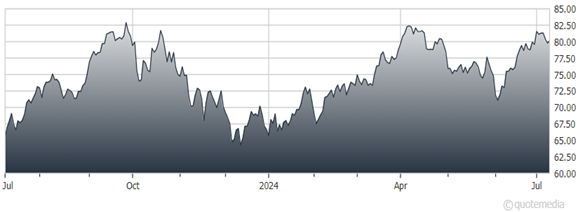The Energy Information Administration (EIA), in their Short-Term Energy Outlook, not only raised their price and demand projections but acknowledged that we are going to see a supply-versus-demand imbalance when it comes to oil. We are facing a very tight market for oil and natural gas is holding up pretty well, suggesting that a bottom is in the making, advises Phil Flynn, senior energy analyst at The PRICE Futures Group.
The EIA said that global oil demand this year will reach a record 103.8 million barrels a day. But at the same time, their projection of daily global oil production is inside 101.98 million barrels a day. That means that based on those assumptions, we will see global oil inventories decline by 1.82 million barrels every day.
United States Oil Fund (USO)
The EIA says they estimate that global oil inventories will only fall by 0.5 million barrels per day (b/d) in 1H24 and will fall by 0.7 million b/d in 2H24. Because of that, the EIA also had to raise their oil price forecast, now saying that Brent crude will average $89 a barrel in the second half of the year. That is up from $84 a barrel in the first half of the year. Regardless of how you do the math, it’s clear that because we’re heading into a supply deficit, the chances of upside price spikes have increased.
Any weather-related supply disruptions or geopolitical events could leave the market vulnerable. And the market must price in this risk, especially because we have seen our Strategic Petroleum Reserve (SPR) gutted in recent years. This comes as EIA had to raise its 2024 demand estimate to 1.11mbpd (was 1.08) and raised the 2025 estimate to 1.77mbpd.
Meanwhile, they said that after reviewing the responsiveness of fossil fuel generation to natural gas prices, they now expect more power generation from coal and less from natural gas than in their previous forecast, especially during the winter. The EIA on natural gas said that the Henry Hub natural gas spot price will average almost $2.90 per million British thermal units (MMBtu) in 2H24, up from $2.10/MMBtu in 1H24.
At the end of June, there was 19% more natural gas in US inventories than the five-year average (2019–2023). We expect less natural gas injected into storage than the five-year average this summer season because of relatively flat production in 2H24 and a seasonal increase in demand from the electric power sector.
Be sure you hedge on your oil and gas needs.

















